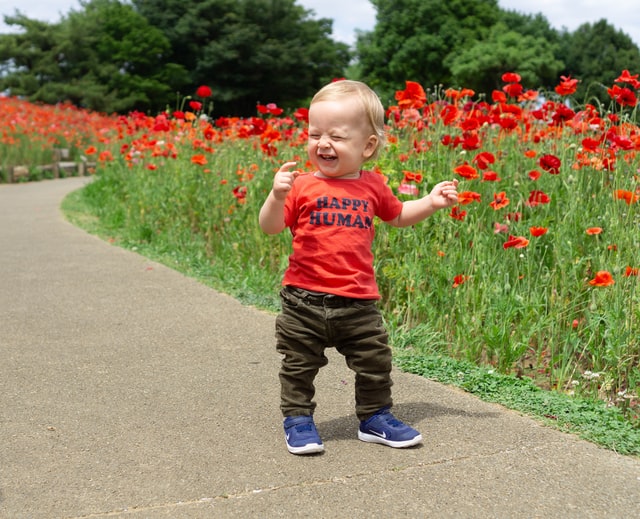An Integrated Approach to Infant Development Based on the Feldenkrais Method
By Chava Shelhav, PhD
with Orly Gat and Tomer Hollander
Published by North Atlantic Books, Berkeley, California
All Right Reserved
Excerpt courtesy of Somatic Resources and North Atlantic Books.
Available from FeldenkraisResources.com, Better Bookstores and Amazon.com
First Steps: As Walking Evolves
When the infant has already learned to stand, and he can stand by leaning on a couch or on a chair, the world around him supplies stimuli that lead him to move toward them. He discovers the possibility of walking while supported. The support helps him stabilize his upper body and allows him to freely move the lower half of his body. The infant transfers his weight by leaning on a source of support in order to lift a leg and place it in a new spot. Surprisingly, most infants begin with side stepping, known as cruising, before they take steps in a forward direction. The following are the reasons for this:
- The supporting foot stays in full contact for the duration of each step when stepping sideways. In contrast, walking forward requires the infant to shift weight from the heel to the arch, and then to the toes, which means that a more advanced organization and balance are needed.
- Shifting weight sideways is done in a way that requires less differentiation in the movement of the joints of the body than walking forward. Side stepping (cruising) is a kind of falling onto the foot, so that the foot, the pelvis, the torso, the hand, and the head move as one unit in a global movement.
Cruising along furniture
This kind of walking serves as a laboratory for the infant in which he explores the way he uses his hands while standing and walking. When he steps sideways, one hand supports him, and when he lets go of the source of support with his other hand, he must choose where to place it in order to support his weight at the end of the step. This movement is done in coordination with his stepping leg and serves as a preparation for coordinating the movement of his limbs in unsupported walking.
Each infant has a favored hand and leg with which he prefers to side step. This is a natural development. However, it is a good idea to pay attention to this preference and to offer the infant opportunities that will encourage him to cruise in the other direction as well. Reality offers opportunities in which the infant will be interested in going from one piece of furniture to another. He learns to take chances, to shift his hand to the next piece of furniture and move toward it. This is an intermediary stage before the transition to forward walking. It is important to offer the infant opportunities for independent trial and error, so that he will establish his balance and the organization necessary for walking. The tendency of many parents is to hold their infant’s hands, thinking that in this way they are helping him to learn to walk, but there is significance in letting him try on his own so that he will experience a sense of daring, success, failure, and independence.
There are children who will use other intermediary stages on their way to independent walking, such as:
- Forward walking using one hand for support. He can hold onto a piece of furniture close to his body, or a railing.
- Two hands hold on to an object in front of his body, such as a chair. He pushes it along, which leads him to walk forward.
Certain walkers force the toddler to stand or move at a speed that does not afford him enough control. Furthermore, these walkers often do the work for the toddler, and thus take away the opportunity to learn movement elements and balance strategies vital to the action of walking. Therefore, we recommend choosing walkers that supply resistance, so that the toddler is required to push them on his own, at a speed that he alone controls. A chair with a toy placed on top of it does the job very nicely.
Transitioning to Independent Walking
Toddlers who begin to walk discover how to keep their balance while moving over a narrow support base, which practically means standing on one leg. By this stage the skeleton and muscle mass have developed in a way that enables the infant to bear her own weight without support. This achievement brings joy and pride to the infant and to her parents.
Infants in the first stages of learning how to walk face a challenge of multiple variables as they work through how to move each muscle, and when. To simplify the problem, they begin to walk by inhibiting movement of the joints of the upper body, by holding their arms raised on either side of the head in a set position, and by keeping the shoulders, chest, and head in a fixed position (Ledebt 2000). They move their same-side arm and leg together and waddle from side to side, advancing in this way. This movement pattern is known as homolateral or ipsilateral walking (Alexander et al. 1993).
The infant has already crawled contralaterally (moving with the opposite arm and leg), and now she returns to the initial primary pattern of advancing homolaterally. Why is that? If we take a look at each developmental stage, we can see that the continuum of learning consists of progression, regression to more familiar patterns, and relearning under new conditions (Adolph and Berger 2007). The same thing also happens here. In order to feel secure in the options available to her, the infant first regresses neurologically to a simpler manner of action. Homolateral walking demands less coordination between the two sides of the body and of the brain than contralateral walking, which requires greater differentiation between the right and left sides of the body. In contralateral walking the opposite arm and leg are coordinated, while the head maintains stability in the middle.
In the first months of learning to walk, toddlers experiment with a wide variety of patterns of using their legs. They often limit the movements of the hips, the knees, or the ankles (Chang et al. 2006) in an attempt to investigate how to stabilize the joints and how to move them, as well as the appropriate timing of each action. Out of the three possibilities of stepping (with the toes, the heel, or the entire foot), most prefer to step first with the whole foot, a choice that requires less differentiation while not being particularly efficient. Gradually they change their stepping preference by first stepping on the heel. This kind of stepping demands a greater coordination of the ankle movement with the rest of the body and allows for a more efficient shifting of weight (Hadders-Algra 2000). There are infants who adopt walking on their toes, who have difficulty with or avoid lowering their heels to the ground to walk on them. This kind of walking allows for limited stability compared to walking on the whole foot. When this option is the only one that the infant uses, it is best to help her develop other options.
As she gathers experience in walking, the infant gradually lets go of movement patterns that are not suitable and focuses on patterns that allow her to keep her balance for one step and then for the next, until her manner of walking is sufficiently mature and stable. She inhibits the movements of her leg joints less and less, and she uses them in a continuous way in her walking style. In this way, the range of her possibilities narrows, and she repeats the most efficient patterns again and again. Through this ongoing process she acquires experience in walking.
Research shows that walking without support is the crucial factor in developing quality walking. During the months of attempts at walking, the infant lowers her hands to her sides and gradually allows her head, chest, and arms to move. Her steps become longer, the spacing between her feet becomes narrower, the direction of her walking becomes clear and uniform, and her steps become similar to one another (Adolph et al. 2003). With expanding control over coordination between body parts, over balance, and over the head’s freedom of movement, the infant gradually shifts to contralateral walking—moving the opposite arm and leg together.
The random possibilities that the environment offers lead the toddler to also walk backward. She adopts backward walking as a variation of forward walking. The importance of this experience is significant: the infant practices organizing her posterior muscles. Shifting weight onto the foot is done differently. The movement is less dependent on the sense of vision and more on the kinesthetic sense, and space perception improves. Eventually, out of the wide range of possibilities with which she began, the toddler adapts her manner of walking that characterizes her. The variety of possibilities that provide stability in walking is enormous, and each toddler sooner or later acquires her very own style of walking. This style is influenced by genetics, body build, muscle tonus, varying body proportions, and cultural practice. In order to develop the elements of independent walking, the infant requires freedom to experiment, so that she can make mistakes and make discoveries. In this process the parent’s role is to give the child her own space and her own pace. The chart below summarizes walking from its inception to its achievement.
| Movement at the Start of Walking | Movement in Mature Walking |
|
|
About Chava:
 Chava Shelhav, Ph.D., was one of the first fourteen students trained by Dr. Feldenkrais. She continued to work with him for many years and served as his assistant in the Amherst training. She went on to earn her MA degree from Boston University and her Ph.D. from Heidelberg University. Chava has achieved distinction through her work with infants and children. During the last forty years, as she trained thousands of students. She created “Child’Space” – a method of developmental coaching that applies Feldenkrais theory to working with babies and their caregivers.
Chava Shelhav, Ph.D., was one of the first fourteen students trained by Dr. Feldenkrais. She continued to work with him for many years and served as his assistant in the Amherst training. She went on to earn her MA degree from Boston University and her Ph.D. from Heidelberg University. Chava has achieved distinction through her work with infants and children. During the last forty years, as she trained thousands of students. She created “Child’Space” – a method of developmental coaching that applies Feldenkrais theory to working with babies and their caregivers.

